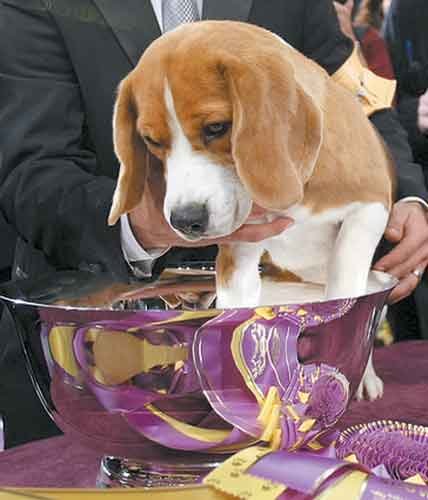The 2008 Westminster Kennel Club dog show at New York’s Madison
Square Garden is history. And the winner made headlines in a lot of
ways. Uno, a 3-year-old beagle, was selected best in show, the
first time this breed has ever been chosen top dog. With his
victory, Uno single-handedly did more for the popularity of the
beagle breed than anyone could have done in months, even years. His
face popped up on television screens around the country, and so did
his voice. That’s right, Uno bellowed his call everywhere as he
trotted around the ring, winning the adoration of millions for his
high-spirited personality. Uno’s howl and the roar of the crowd
proved to the judge that he had chosen the right dog as this year’s
best.
The 2008 Westminster Kennel Club dog show at New York’s Madison Square Garden is history. And the winner made headlines in a lot of ways. Uno, a 3-year-old beagle, was selected best in show, the first time this breed has ever been chosen top dog. With his victory, Uno single-handedly did more for the popularity of the beagle breed than anyone could have done in months, even years. His face popped up on television screens around the country, and so did his voice. That’s right, Uno bellowed his call everywhere as he trotted around the ring, winning the adoration of millions for his high-spirited personality. Uno’s howl and the roar of the crowd proved to the judge that he had chosen the right dog as this year’s best.
Westminster is the granddaddy of all dog shows. And it attracts some of most interesting of all canines to compete against each other. There are dogs small enough to hide under a handkerchief, and others so large that they can almost be saddled up and ridden. There are poodles with their topiary appearance standing in stark contrast to mop-haired Old English sheepdogs whose long fur covers their eyes. Dobermans look completely different than bulldogs. Sleepy little pugs contrast completely to the energetic Brittanies.
This is a show where one can learn about a lot of the more obscure breeds. Some of the most interesting this year were the Beauceron, a French herding dog with a somewhat flighty personality, and the Tibetan mastiff, a chiseled-looking working dog. There were komondors and plotthounds, pulis and a Finnish spitz. All mixed in with the well-known cocker spaniels and golden retrievers.
And there were some famous people at the show as well. Perhaps the most notable was Patty Hearst with the second place winner of best opposite sex. Her French Bulldog, Diva, was a gorgeous little girl.
But the show belonged to Uno, and he knew it. And he let everyone else know it as well. Hail to the beagle. He’s on top, at least for this year.
Q:
With all the new “designer breeds” of dogs, my friends were talking the other day and wondered if any of these might someday become a legitimate breed at an AKC dog show. What are the possibilities?
A:
Chances are probably not very good, despite the huge popularity that some of these crossbred dogs have recently enjoyed. From the labradoodle to the mork (a maltese/Yorkshire terrier cross) and all the others, we have to remember that in their first generation, these dogs are nothing more than, well, mutts. And while I’m not quite sure how the American Kennel Club goes about deciding when to certify a new breed, I do know that it takes many, many generations for a new breed of dog to develop. So even though some dogs have a common background, (some breeds have actually developed as an outbreeding of another), it isn’t an overnight process. And who knows what you might get if you bred one labradoodle to another. After 10 or 15 generations, what would these dogs resemble most? A Lab or a poodle? Maybe in a few decades we’ll find out.
Q:
I hear over and over that male calico cats are extremely rare and valuable. Why is this? And why haven’t clever breeders tried to cash in on this?
A:
As rare as they are, male calicos aren’t worth the thousands of dollars that urban legend would have you believe. And truth is, it’s impossible to breed one of these oddities and get any offspring anyway. That’s because genetically, they are misfits.
The calico color pattern is sex-linked. The tri-colored pattern of the calico kitty is transmitted on the X chromosome. So cats that have a calico color pattern are female with the XX chromosome combination. Males, with their XY chromosomes can’t typically be calico colored. The exception to this rule is when a genetic aberration occurs. If instead of the usual two sex chromosomes (XY), a cat has an XXY triple chromosome makeup, he may outwardly appear to be a male cat. But the triple chromosome renders him infertile. He cannot reproduce. So a male calico may be somewhat rare, but he can’t sire any more of his own kind. He’s actually just another nice looking kitty.














